Welcome.
I am Mauricio NOVOA MUNOZ.
I am a designer with 35 years of industry experience in Australia and abroad, and an industrial design (ID) academic and researcher for 18 years at the School of Engineering, Design and the Built Environment (SoEDBE), Western Sydney University (WSU). My work enables social transformation and transition to a fair and sustainable society in first and third world countries through innovation in ID, interaction design (IxD), intelligent augmentation (IA), pedagogy, practice, social design, XR (AR, MR,VR), urban and digital futures.
Active learning and researching the new dynamics, roles and processes for design professional from conceptualisation to design, development and production with up an coming cyber-phisical and intelligent technologies
New design pedagogy for a post-industrial society with a combination of design, sustainability, affordability and investment. The design artifact and their built and human environment are no longer the same as in the Industrial Age. Design for styling is no longer enough. We need a life-centred design approach capable to run design ethnography, create and co-create tangible and intangible experiences for end-users. All these with an understanding that our present and future are impacted by climate change, digital transformation, and new geopolitical powerplays. We need to transition to a sustainable future that requires change of behaviour, tradiions and rituals.
Manifesto for innovation in research and design education. New technologies are changing our teamwork dynamics, tools of trade and market. Today's post-industrial era contests old divisions of power and development after globalisation and technology diffusion. Traditionally a measure to differentiate 'haves from the have-nots", technology will not be effective until it is widely accessible.
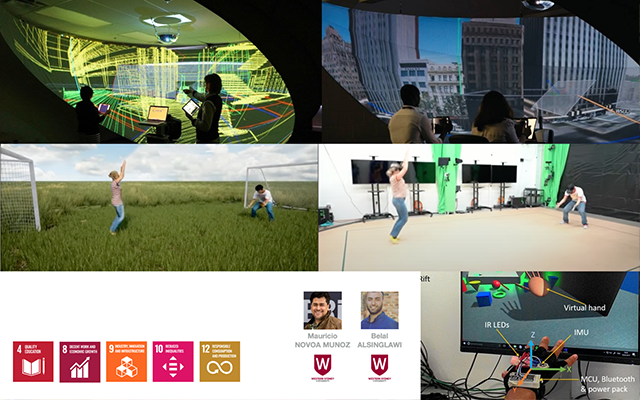
Following on previous funding (ARC Discovery), I finished the setting up of the XR and Visualisation Lab for our School of Engineering, Design and Built Environment in 2022. The lab intends to imagine, visualise and test new experiences to redefine design, housing, human and machine interactions, and urban futures. As per examples shown, the semi-immersive Hyve3D allows to sketch, design and navigate new environments. Our Antilatency sensors and infrared flooring allow to map and track participants positions, movements and interactions with either digital and,or physical objects and environments
Joint project with leading Universities of Cincinnati USA and Montreal Canada. The research intends to create a better future by solving problems of today. It will be conducted as a user-community centred research to frame meaningful insights and envision the future of our cities, their inhabitants and the transport and artifacts they will interact with.
A selection of discoveries after the authors performed research, made presentations and mediated workshops when face-to-face collaborations and travel were impossible because of the Covid-19 epidemic restrictions. Findings add to work intending to build a modern taxonomy for design sketching and visual knowledge while accounting for immersive virtual collaboration and distributed workflows from sketching to 3D CAD and 3D prin.
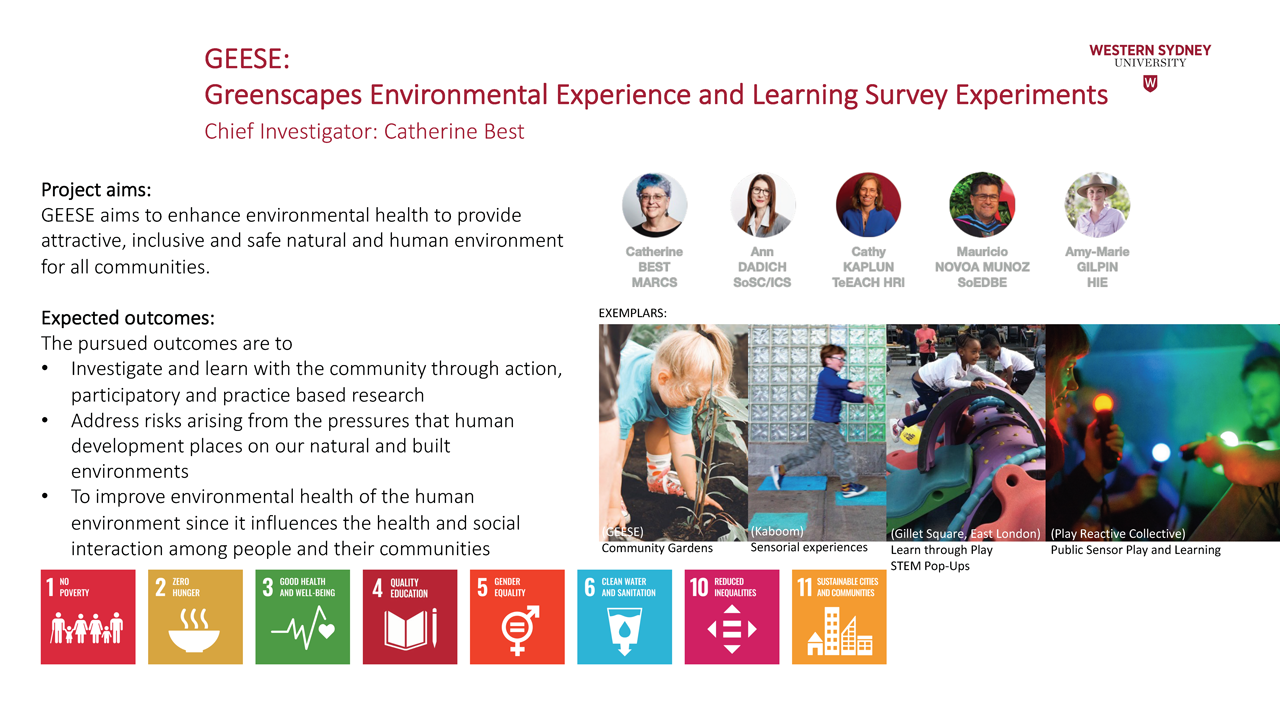
Alinging with Environmental Health Australia , GEESE platform and our research are to enhance the practice of environmental health to provide a healthy, safe and attractive natural and social environment for all communities. GEESE offers opportunities to learn about and be part of fun, educational initiatives to promote communities and environmental health and wellbeing.
These are examples from the subject ENGR1041 Designing for User Experience (UX). It focuses on learning UX with new XR and VR technology. Students design and develop their own low-cost VR equpment and prove the success of their work with design ethnography user observations and mappings, and a final MVP working prototype used to play VR games. UX is a newer form of desing that includes industrial design. As per Norman (2000), "I invented UX because human interface and usability were too narrow. I wanted to cover all aspects of the person's experience with a system, including industrial design, graphics, the inerface, the physical interaction and the manual".
Longitudinal research project in the last design studio for the degree. It was based on active learning, critical pedagogy and making, industry parntership pedagogy and WIL. Academics and students in five countries (Australia, Canada, Chile, Germany, Netherlands) worked as equals with a commercial design firm setup. Participants formed globally distributed teams of students, academics, industry and government experts. Co-design resulted in MVP working prototypes ready for manufacturing in China in one semester. Several students received direct offers for commercialisation of their designs. Government wise, the project was used to promote AUSTRADE and Austraian International Education (AIE) in their South America Rallies (2006-07). WSU conferred for it an Excellence for Learning and Teaching Citation in 2012.
Award winning Honours project by Mr. Jordan Rohr. With the rate of overweight and obesity among Australians continually on the rise, questions must be asked of the traditional methods used to solve the problem which have so far proven ineffective. Government reports place the focus on ‘active transport’ such as walking, cycling and the use of public transport, however a lot of work needs to be done to change the habits and behaviours of the population in this area.The Hummingbird is a product-system for urban environments that aims to engage, encourage and incentivise individuals to become more physically active to impact on the growing health problem facing Australia through progressive, rather than immediate habit changes. .
Supervision of ID Honours students projects alongside work with Prof Mark Armstrong (Director Blue Sky Creative Group, Adjunct Professor at Monash University), and University of Technology (UTS). The new product development of smart child restrains for inside car safety assisted in the setting up of a new business vision for the company. Infasecure established its first design department, employed our graduates, and implemented a business strategy that helped their business grow to own three factories in China and capture more than 20% of the global market.
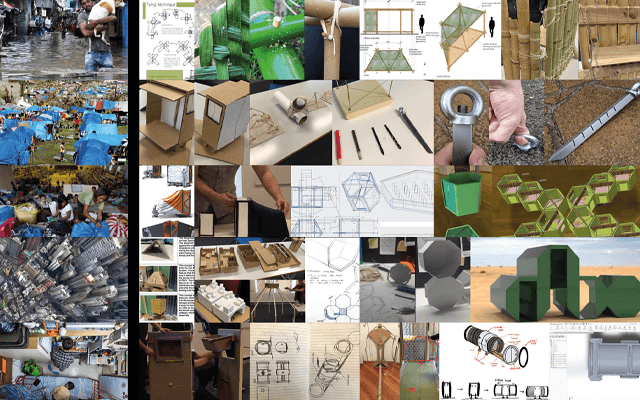
Design studio work for subject ENGR300: Innovation trhough Systems Thinking. The subject investigated the complex challenge of rethinking housing for a growing population who will not be able to afford their own home in Australia (millenials, genz, over-50, single women, homeless) and in developing nations because of emergency and resilience. Students designed after carrying out design enquiry and design ethnography with people who are or have experienced that kind of need.
A project-based learning subject that introduced students to learning how to negotiate physical and digital components to form smart artifacts. That relation is represented with the development of an interactive robot and its digital mirror counterpart as its avatar. The subject also assisted in the preparation of a professional portfolio showpiece for job applications in the industry. Learning by experimentation, the subject linked traditional skillsets including software and 3D printing with new forms of design, from engineering narratives to digital creativity within augmented and virtual environments.
Usability testing of game operation, human-computer interaction and water control. For in depth read on the persuasive design to change habits at home go to Research/Social Design to Influence Change
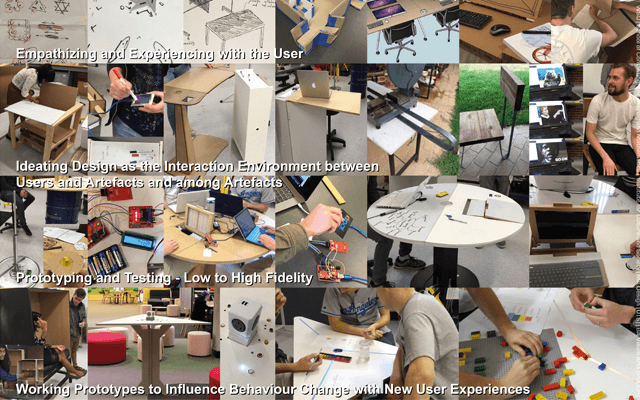
The studio focused on people, places and systems design to resolve the challenge of the new digital-physical built environments we llive in. The subject built expertise on human environments, responsible design, human-centred design, and technology development, such as interaction and tangible design through applied design research, contextual inquiry, protototyping and testing to working proof of concept level. The subject was delivered with an industry partnership pedagogy with experts from different areas of design and manufacturing. Notably among them, Mr. Andrew Ford, National Director for Research and Innovations at SEBEL Furniture.
As per modern design benchmark, students design needs to be proven right beyond sketching and visualisation, with practical usability and material testing. Heuristics are practical methods that are not guaranteed to be optimal, or perfect but are sufficient to reach short-term goals and approximation to a final working proof of concept prototype.
Design-based research to improve physical and social development of chldren between between the ages of 3 - 5 with tangible interactive sport based play. The project included the design, evaluation and implementation of an itneractive sport toy, GiggleBat, that merges benefits of co-design, HCI and user-centred design assisted with Arduino sensors and 3D printing..
A framework for current use and future potential for drawing to present, represent, simulate and visualise the world within the education, industry, practice and research landscapes.
This century, the built environment, and specifically the learning space, have expanded from physical to digital and virtual envrionments, from non to fully immersive experiences. The research includes students as both designers and end-users. It seeks a value proposition that redefines design for the built environment and the objects within it. Today, digital materialities are increasingly taking over operations that were physical before, there is a new kind of intellectual mass manufacturing as a process of knowledge construction instead of hardware products for consumption only, and new rituals that affect social change and interaction.
International Honours Supervisor of Ms. Aaleen Parulekar from Symbiosis Institute of Design (SID), Pune, India. I am currently her Main Supervisor in her MRes and a Memorandum of Understanding (MoU) is about to be signed between SID and WSU to develop joint academic and students exchanges, joint research projects, and potentially a MDesign delivered from Australia. Ms. Parulekar's candidature follows up on her winning IIT Mumbay-D'Source Corona Design Challenge. She envisions to continue her reseearch with her PhD in WSU. Her awarded project was about rapid deployment of temporary housing shelters for victims of post natural disasters (e.g., Covid-19 housing and rehabilitation rooms, monsoons and floods). She focused on the critical period of 3 to 10 months after disaster when normally there is no organised assistance. Commonly, victims of disaster keep living in temporary shelters for a long time after suffering from natural and economic disasters.
The study focuses on water conservation as scarce premium commodity in Australia. Literature review finding showed water sustainability requires more than efficient planning and regulation. Behavioral change through persuasion is pivotal. Researchers found that change happens preferably through daily familiar practice rather than regulatory or financial penalty, as with water bills. One such instance is the daily ritual of bathing where parents/guardians and children connect with each other through a task and also allows for a child to increase experiential learning through play. Project findings led to a working minimum value product (MVP) and system solution closer to deployment with a subgroup of possible customers or early adopters.
Conference Best Paper Award. A case study on design thinking for a new ID Honours program. Multi-disciplinary student projects allowed to promote new forms of ID as IxD, HCI and UX. A renewed culture and environment emphasized seeking functionality and fidelity, user and society value over beauty and form factors alone. The pedagogical approach sought to determine the new industrial products reality with an increasing contribution by design thinking and its associated methodologies that are currently advancing typical Industrial Design. The authors proposed a number of reflections as recommendations, which may be useful for educational institutions contemplating similar curriculum makeovers to their design degrees.

Award winning Honours project by Mr. Omar Alrawi. E-Trix is folding e-bike vehicle able to be manufactured in small runs to ensure a unique user experience for people who want to be a part of a cleaner and greener city. Thanks to its smart belt-drive system, E-Trix combines high functionality, low cost and sustainable recycled materials that are rotational formed into components with metal detailings that minimize extra parts, bolts and screws.

Quick A3 three hours one sitting watercolour portrait.

Live A5 three minutes sketch of a child in the street.
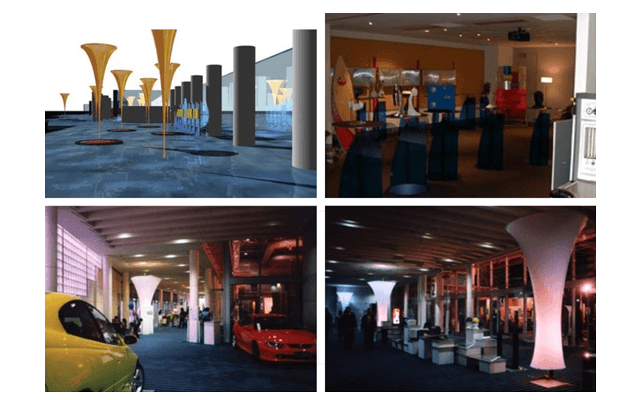
Complete design process from ideation to design, managemment, development and production. Exhibition and set design included the fabrication of metal and plastic structures, digital media production, installation, graphic design and speech writing.
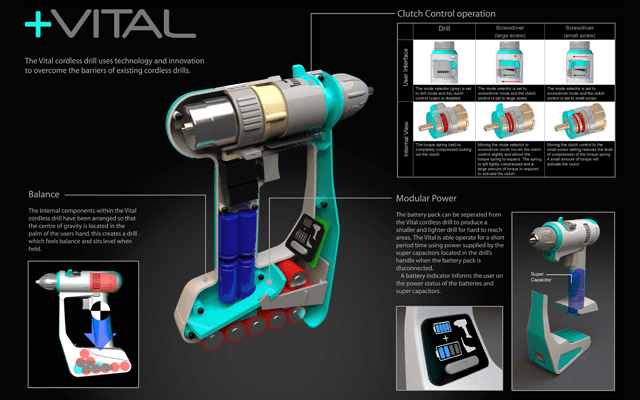
Supervision of Honours project by Mr Ben Scotman. Vital Cordless is a power drill for the female market with self charging batter system for longer use

Supervision of Honours project by Mr Bobby Lowe for the City of Sydney. Multitasking car design concept starting from current Tuk-Tuks in Asia. From tours around the city to a mini delivery truck that can deal with the small streets in the CBD and its conversion to a forklift to drive in and stock goods in the fresh market

I frequently demonstrate and teach XR, AR, MR and VR tools to my students and colleagues in Australia and abroad.
Sunny Corner Toy Library is a not-for-profit organisation established in the suburb of Auburn, Sydney, since 1983. It aims to provide the children of the community and their families with an ever-changing variety of educational and fun toys to enhance their cognitive, social, emotioinal and phhysical development in the important first six years of their lives.

Live A2 three seconds sketch of a reclined model.
I have worked in architecture, advertising, communications, marketing, product and industrial design, management and manufacturing with outcomes on diverse dimensions (2D, 3D, 4D time based and interaction). In the industry, I reached director roles (creative, management) in portfolios for American, Asian, Australian and European companies (Blue Chip, SMEs). I have often travelled between cities and countries to lead and produce projects. Highlights are high-tech projects for companies in technological innovation (e.g. electronic, construction, medical), durable and fast moving consumer goods (e.g. commercial and domestic appliances, tools, packaging), extended reality (XR), human-centred design (HCD), human-computer interaction (HCI), industrial design (ID), interaction design (IxD), online and flexible learning (e.g. e-commerce, e-learning), simulation, visualisation, user experience (UX), intelligence augmentation (IA) and internet of things (IoT). On the side of low-tech for the Global South, I have worked in technology difussion projects and training for third world agriculture (Pakistan), digital and physical transformation (Pacific Islands), disaster, emergency and resilience (India), and global design studios (Canada, Chile, Germany, Netherlands). All these based on a social design and ethnographic vision powered through critical making and open design, distributed design, maker culture, and peer-to-peer commons.
Locally, I was Director of Academic Program (DAP) for our Industrial Design Honours, Industrial Design, and Design and Technology courses at SoEDBE and led curriculum transformation to bring these programs from Industrial Age teaching (art and assembly techniques) to a 21st Century STEAM (Science, Technology, Engineering, Arts and Mathematics) and 4.0 Industrial Revolution framework based on agile-critical making and new pedagogy (transformation and transition design). I hold a PhD Culture and Society from the Institute for Culture and Society (ICS, WSU) after undertaking an eight years longitudinal study to propose New Pedagogies for Design: Revaluing the Design Artefact for the Post-Industrial Revolution. Research wise, I lead our SoEDBE XR and Visualization Design Laboratory, I am core member of our SoEDBE Design and Digitalization Research Theme Group, and also associate member of our Urban Transformation and Advanced Manufacturing Research Theme Groups. In parallel, I am member of GEESE (Greenscapes Environmental Experience and Learnnig Survey Experiments) group at TeEACH (Transforming early Education and Child Health Research Centre). I gained a Master of Design from University of Technology Sydney (UTS) with a thesis on the influence of technological development on the profession and society, and a Bachelor in Fine Arts with first class Honours equivalent from the Pontificia Universidad Catolica de Chile (PUCC).
Internationally, I am a Senior Fellow of the Higher Education Academy, UK (SFHEA PR214060) and member of international professional bodies, such as, a Steering Committee Member for the Design Society, UK, Special Interest Group Design Sketching and Visual Knowledge, Advisory Board Member to E-Learning and Innovative Pedagogies Research Network. Illinois University, USA, and Curriculum Development Panel Member for universities in the United Arab Emirates and Latin America, Guest Editor for international journals, Peer Reviewer for international conferences, an I work in academia-industry projects. My work and supervision have been awarded and cited nationaly and internationaly. I am often guest speaker and present in conferences on design, HCI, learning, manufacturing, new digital technologies and sustainability.
I believe that we need a multi-stage iterative process to influence habitus and behaviour of people and organizations to create sustainable changes. That will hopefully produce a system-level transformation capable to repair the link between nature and human environments that has been damaged by globalization and industrialization. That transformative effort will also create a beneficial planetary legacy in case that humankind ends. These are matters that need dicussion in academia and the industry. Many designers and design educators are generally comfortable with industrial revolutions (IR) for consumption that are manual, mechanical (IR 1.0), electrical and mass produced (IR 2.0). Yet, many need to catch up with changes brough about by IR 3.0 (digitalization) since the 1970s, and more recently IR 4.0 (cyber-physical, algorithms), and IR 5.0 (artificial intelligence, neural networks) to effectively influence social transition to a sustainable future. Relating to HDR supervision, in 2022 two of my PhD candidates obtained their doctorates. I have other five as principal supervisor that are progressing to their confirmation of candidature. My PhD students and I are researching on the topics of:
Machine Learning and Artificial Intelligence:
Predictive analytics framework for electronic health records with machine learning advancements: Optimising hospital resources utilisation with predictive and epidemiological models (completed)
Mobile Learning Technology:
Technology and Islamic education for non-native Arabic children (completed)
Design, Digital and Urban Futures:
Co-creating the Built Environment and Design Thinking to Effectively Deliver Transformative Learning and Innovation
Technology Creation and Diffusion:
Integrating Physical and Digital Technologies to Develop Higher Education KKNI-Based Curriculum in Indonesia
New Critical Thinking for the Profession:
A Constructionist pedagogy for co-creating knowledge in interdisciplinary programs
Digital and Phisical Transformation:
Designing physical and digital transformation for Samoa and the Pacific Islands
Redefining the Housing Footprint:
Designing for modular housing in emergency and resilience contexts
Health and Human-robot Interaction
Assisted Cerebral Palsy Therapy with Human-Robot Agent Interaction
Examples of different acknowledgments to my work as a designer, lecturer, researcher and supervisor of projects
2024: Design Research Society Conference, Boston, USA. Chair for Track Design Sketching Futures: Analogue, XR and AI .
2023: Design and Urban Futures Research Project: Future of Mobility and the City. Partners: University of Cincinnati, USA, and University of Montreal, Canada.
2023: Journal Guest Editor: Revista BASE, Diseño e Innovación. Universidad del Desarrollo, Chile (Call for Paper Launch on 9th January 2023).
2023: WSU Research on AI: Attitudes and perceptions of WSU staff and students to artificial intelligence. Team: PVC Learning Futures Prof. Simon Bedford, Thillagavathy Rajaretnam, Levi Osuagwu, Walid Bakry, Mauricio Novoa, Edward Anyasodor, Peter Denyer-Simmons, Felicity Picken, Vincent Tay, Myra Gurney, Dianne Dickenson, Ray Archee
2022: Interview in Computing For Sustainability: Saving the earth one byte at a time, Otago University Radio: Computing for Sustainability: Saving the earth one byte at a time: Designing Living-Centred Solutions (Episode 387, 3 June 2022)
2021: Senior Fellow of the Higher Education Academy, UK (SFHEA PR214060)
2021: Leader of Workshop: New Immersive Workflows for Design and Production. Team from WSU, Brygham Young University, Canterbury University, Hardt Hyperloop Netherlands, TU Delft. Society of Design Research Society, Learn X Design International Conference, Shandong University, China
2021: Co-Leader of Workshop with Education Director, Industrial Design Society of America: New Forms of Ideation Workshop. Team from WSU, Iowa State University. 23rd International Engineering and Product Design Conference, VIA Design and Business University, Herning, Denmark.
2021: Leader of Workshop: New Workflows for Design, Visualization and Production. Team from WSU, Brygham Young University, Canterbury University, Hardt Hyperloop Netherlands, TU Delft, VIA Denmark. 23rd International Engineering and Product Design Conference, VIA Design and Business University, Herning, Denmark.
2021: Guest Presenter: Exploring Designāre Theory. Plenary Session, Design Theory Symposium, Mines Paris Tech.
2020: Table panellist: The Value of Design Engineering Education in a Knowledge Age. 22nd International Engineering and Product Design Education Conference, VIA School of Design and Business, Denmark
2019: Student Award - Australian Good Design Award on Social Impact. Jordan Rohr supervision. Persuasive/HCI Design for Health and Wellbeing
2018: Guest Speaker: New Ways of Being that Redesign Human and Machine. Identities, Labor and Participation in a 4.0 Revolution of Industry and Humanities, 18th ACM International Conference on Intelligent Agents, Robots and Artificial Intelligence, WSU. NOTE: Other participants were Director of Social Robotics at UNSW, Cognitive Interaction Technology (CITEC), Bielefeld University, University of Technology, Digital Cultures in the Department of Media and Communications at the University of Sydney, Department of Neuro-Ethics at University of Tasmania, Philosophical Psychology at University of Wollongong, Artificial Intelligence at UNSW, Human-Robot Interaction at UNSW, HIT Lab NZ, Internet Studies at Curtin University, Philosophy, Humanities and Language at University of Jyväskylä in Finland
2018: Altmetric Mentions - Policy document: Analysis and Policy Observatory (APO). Centre for Design Innovation: Biennial Report 2018
2017: Interview for Book Sustainable Lens by Professor Samuel Mann, Otago University, NZ, Otago Regeneration Radio: Knowledge ecology for Industrial Design
2017: Guest Speaker - The Role of Space and Environment in the Construction of New Learning and Knowledge Ecologies 2017. International New Generation Learning Space Design Conference, UTS Sydney
2016: Best Paper Award - Towards the successful integration of design thinking in industrial design education, International Conference on Educational Technologies, RMIT Melbourne. NOTE: The paper presented practical case study implementation of modern smart industrial design and its education to promote persuasive design to influence behaviour change
2016: Offer for commercialization for GiggleBat Project from Big Data and IoT Research Group, Institute for Future Transport and Cities, Coventry, UK. NOTE: GiggleBat was the prototype of a smart and interactive cricket bats and tennis racket that assist learning and socialisation in pre-schoolers
2016: Grants - Two Research Initiative Funds: GiggleBat, STEAM Ball HCI projects, WSU Sydney
2015: Citation - Andersen, L., Ashton, P., Colley, L. (2015). Creative Business in Australia Learnings from the Creative Industries Innovation Centre, 2009 to 2015. Sydney, Australia: UTS
2015: Curriculum Advisor - International Panel Member for American University of Sharjah, UAE
2014: Advisory Board Member - International Conference on Education and New Learning Technologies, EDULEARN14, IATED, Barcelona
2014: Students Awards - National Cormack Packaging Competition. Timothy Lee (first prize) and John Ballantine (second prize) supervision (together with Mr Paul Bingham). Container Revival for traditional packaging in boxes, tubs and jars. Sydney.
2013: Students Awards - National Cormack Packaging Competition. Michael Rudd (second prize) and Shane Prasad (highly commended) supervision (together with Mr Paul Bingham). Container Revival for traditional packaging in boxes, tubs and jars. Sydney.
2012 - 2014: Grants - Several Infrastructure Funds (to build classrooms, workshop and 3D printing labs), WSU.
2012 - 2014: Grant - E-Portfolio Lifelong Learning and Teaching Enhancement Grant, WSU.
2012: WSU Citation for Excellence in Education. Outstanding Contributions to Student Learning, WSU.
2010: Citation - Arts, Design, Media – The Higher Education Academy. Dissemination of Innovative Teaching and Learning Practice Report , ADM-HEA, UK.
2010: Speaker Invitation (Team) - Water: Challenges of its Scarcity, Sixth International Fundacion COPEC-Pontifical Catholic University , Santiago, Chile. NOTE: The Symposium came about from lack of water in north of Chile where mining industry uses the scares water available for mineral refinement and needs to clean it before it is drinking water again and for agriculture
2010: International External Advisor invitation for Pontificia Universidad Católica de Chile, School of Design new Master’s in Advanced Design (MADA). This is a special course that works simultaneously with business, design and technology with sustainability at its core.
2009: Guest Speaker - Australian Findings on Preparing Industrial Design Students for the Global Emerging Economy. ALTC National Design Studio Forum: Studio Teaching as a Creative Arts Pedagogy, UTAS, Tasmania
2009: Student Award/Exhibition - Society of Responsible Design, Change 09, Sydney. Omar Alrawi supervision. Sustainable Transportation (E-Trix Folding Bike).
2008: Keynote Speaker: New Opportunities for Technological Innovation Conference,. Santiago, Chile Funded by Chilean government, University of Technology (UTEM), and supported by The Australian government, CODELCO, UTS Sydney, TU/e Eindhoven, OECD
2007 - 2011: Grant - Learning and Teaching Advancement Plan Project: Preparing Designers for the New Markets Economy, WSU.
2006 - 2009: Visiting Academic - University of Technology (UTEM) Chile. United Nations and Chile Ministry of Education Fund.
1993: Exhibitor - The Boundary Riders 9th Sydney Biennale Exhibition, Sydney
1984: Exhibitor - Chilean Artists of the 20th Century touring exhibition with most representative national artists, Santiago, Chile